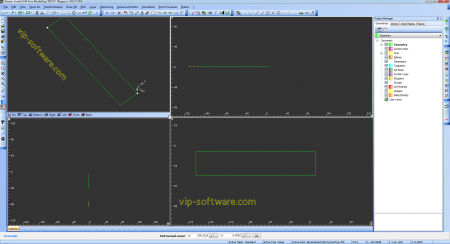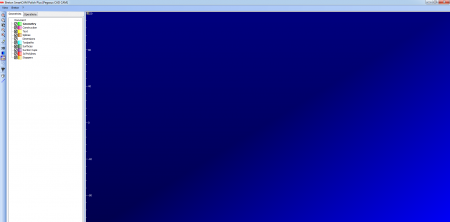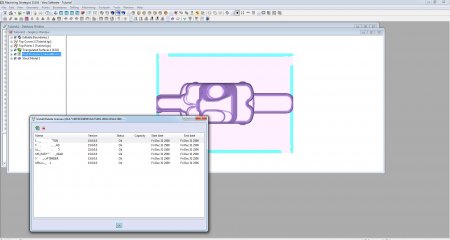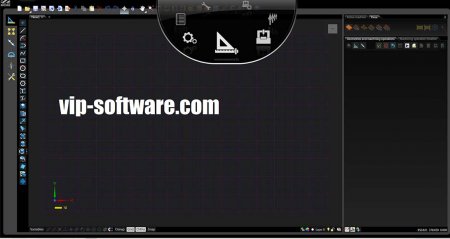Article info
14-10-2015, 08:39
- Views: 2683
- Author: vipsoft
- Date: 14-10-2015, 08:39
Breton SmartCAM 2.2.21 Pegasus Cad-Cam Sentinel Hardware Key
Category: Cad Cam
Article info
8-10-2015, 13:01
- Views: 1541
- Author: vipsoft
- Date: 8-10-2015, 13:01
Machining STRATEGIST ( FlexLM License ) don't need Crack
Category: Cad Cam
Machining STRATEGIST
Take your machining productivity to new heights
Machining STRATEGIST is a powerful 3D CAM product that generates optimum roughing and finishing CNC toolpaths from the complex shapes generated by all major 3D modelling systems. With demands for ever-shorter lead times and improved quality, High Speed Machining (HSM) is now common place in many mould, tool and die shops both in the CAD/CAM office and on the shop-floor to machine hard materials with increased feed rates.
Machining STRATEGIST is a technological leader in this area with many unique machining strategies for generating world-class machining programmes. At the same time, many of these strategies can improve the productivity of older CNC machines with dramatically reduced air cutting time and programmes with smooth arcs which help to maintain continuous machine tool motion.
Installed in a CAD/CAM office or on the shop-floor, Machining STRATEGIST can take your machining capabilities to new levels and productivity to new heights.
Features at a glance:
Smooth motion control machining for all toolpaths
Tooling libraries, incorporating toolholders
Toolholder gouge protection
Drilling
Taper cutter support
3+2 axis machining
Rest machining, including rest roughing and transversal rest finishing
Flat surface machining
Steep/shallow machining option for all 3D toolpaths
Variable stock-allowance to steep and shallow areas
Batch processing, Multi-threading processor support
Calculate multiple processes simultaneously in one database
User Interface
Machining STRATEGIST has been developed to be very easy to learn and use and training is typically only one to two days in total. The software has context sensitive menus and dialog boxes and is intuitive to drive, while many parameters are calculated automatically or remembered to minimise operator input. Operations are driven from a browser-like tree structure that develops to show the history of the job.
On-line help
The on-line help contains comprehensive and easy to understand text and illustrations while every effort has been made to ensure that it is written in plain English. The help is fully context sensitive and displays topics relevant to the current operation and dialogue box. Hyperlinks have been incorporated to guide the operator towards useful related topics, making the online help intuitive and easy to navigate. Reading third-party data accurately is critical to the successful operation of a stand-alone CAM system. IGES 3D surface and solids data can be read in to Machining STRATEGIST together with VDA-FS, STL or direct CATIA interface. An optional native Parasolid reader allows the transfer of Parasolid files from VISI Modelling or other Parasolid-based modellers. Machining STRATEGIST can export STL files, which can be particularly useful after applying fillets to a model.
Multiple Machining Strategies
The range of machining options available within Machining STRATEGIST includes:
Drilling
Z-Level Roughing
Core Roughing
Lace Roughing
Adaptive Roughing
Rest Roughing
Horizontal (Flat Surface) Finish Machining
Z-Level Waterline Machining
Raster (Planar) Machining
Radial Machining
Spiral Machining
Morph Machining
Along Boundary (Scribe) Machining
Axial Offset Machining
3D Constant Offset Machining
3D Corner Offset Machining
Pencil Milling
Parallel Pencil Milling
Transversal Rest Machining
All machining options have techniques for maintaining constant machine tool motion - an essential requirement for maintaining higher feedrates and eliminating dwelling, the single worst contributing factor to tool wear. Any 3D machining strategy, can be controlled by specifying the surface slope-angle to be machined, without the need for steep/shallow boundaries. This means that, in addition to water-lining steep areas, shallow areas can be machined using any of the remaining 3D machining strategies. So a radial part could be finished with a combined steep waterline and shallow radial strategy. All toolpaths in Machining STRATEGIST are created as a two-step process:
(a) Toolpath passes are generated, calculated to a particular tool and tool holder.
(b) Toolpath passes are linked with a home position, rapid moves and toolpath linking moves.
There are a number of inherent benefits to this approach. Firstly, if a different linking strategy is required, it is not necessary to recalculate the original toolpath passes. Secondly, if the original toolpath passes require editing, this is done prior to the linking stage resulting in more control and better linking of trimmed toolpaths. Toolpath linking moves were designed to minimise the time the cutter is spent off the job with the net effect that overall machining times are reduced. All machining strategies can be driven in a 3 2 axis orientation. Machining STRATEGIST in 3 2 axis mode is as straightforward as conventional 3-axis machining with 2D boundaries created in 3D space determining the Z-axis machining orientation, which can be set as an AB, AC or BC rotation depending on the particular machine tool setup. Whether machining with a high speed or conventional machine tool, Machining STRATEGIST can help to reduce overall machining times while improving tool life and providing better machine tool motion.
Part Analysis
State-of-the-art graphics are used to maximise the visual aspects of Machining STRATEGIST. Once read in, imported CAD data can be viewed as wire-frame, wire-frame with hidden-line removal or fully rendered and fully rendered with surface edges drawn. Use of OPEN-GL graphics facilitates real-time dynamic rotation, zooming and panning. Machining STRATEGIST has a variety of interactive tools for analysing the part geometry. By snapping to surface node points accurate measurements can be taken including :
Dimensions
Lengths
Surface Curvature
Slope Angle
Any surface can be viewed at a vector normal to itself and this is particularly useful when positioning the part for 3 2-axis machining.
Fillets
A dynamic sectioning function allows for closer interrogation of cross sectional detail. This can be useful when analysing toolpaths which might otherwise be obscured by steep wall areas or for visually viewing the difference between a remaining material stock model and the finished component. A minimum curvature can be assessed on parts relative to the smallest cutter to be used. By inputting the minimum cutter radius, a new model is generated detailing corners sharper than the specified cutter. Fillets can be used to smooth out the model for machining. Standard radius fillets can be created slightly larger than the ball-cutter to be used. The result will be machining that has continuous movement and no dwelling. Fillets can also be specified to have a different radius to the diameter and this can be useful if 3-axis machining with carbide-insert button cutters. As an example, if machining with a 32r6 cutter, fillets of 34r7 could be created, resulting in smooth, continuous machining even in what were previously sharp internal corners. Fillets are generally produced in seconds, even on large detailed models. With the use of fillets, smooth machine tool motion, better surface finish and improved tool life are assured. Models read in with open hole details can be filled with Machining STRATEGIST, using the planar patch facility, in most cases eliminating the need to take the part back in to a modelling system for modification. Planar surfaces can be modelled if the component is destined to become a core or electrode. If planar holes are located at a vector in space, these can also be filled, by specifying an AB rotation for the boundary used to constrain the planar patch. Machining STRATEGIST automatically looks down the vector path the boundary is created in when performing any associated command such as machining or in this case, creating a planar patch.
Batch Processing
The history-tree structure within Machining STRATEGIST can be used to record a sequence of events. Rather than recording a macro in advance, the user can selectively specify exactly which machining sequences to record after the operation has been run. This allows the user to build up a selection of operations which can be used to automate other jobs. For instance, a sequence of roughing and rest-roughing operations could be recorded using particular cutters for small, medium and large parts.
User-definable Profiles
Within a session of Machining STRATEGIST, the operator can specify the software to retain any values which have been input / overridden. When exiting Machining STRATEGIST, the operator can then save this session as a Profile. Profiles work especially well for different sized components, different operators who wish to work in their own particular style and even different machine-tools, since high speed machine tools benefit from different default parameters to conventional CNC's. Used in conjunction with batch processing, User-definable Profiles can help to make the most of process automation.
Roughing
Machining STRATEGIST's roughing routines employs a number of techniques which, when combined, results in a program with the smoothest cutting motion and significantly enhanced tool life: A series of offset passes are generated at specified Z-depths and are automatically calculated to remove the maximum amount of material without leaving upstands. The depth of cut automatically adapts, ensuring that flat faces are machined to within the prerequisite stock allowance. A Core Roughing strategy is optimised to machine from the outside-in, resulting in better cutting conditions when machine cores or parts with upstands. Upon linking the passes, an "effective cutting diameter" helix entry is calculated, completely machining the material under the cutter as it moves to its next Z-depth. Cutter contact is maintained as much as possible to avoid the reduction of tool life. Machining STRATEGIST automatically adapts to a profile ramping condition following the toolpath as the tool ramps down in Z if a helix entry is not possible. If both a helix entry or a profile-ramp entry would leave material under the effective cutting diameter of the cutter, which might result in the cutter being damaged as it drops deeper in Z, Machining STRATEGIST discards this part of the toolpath, to be picked up later by a rest-material re-machining operation. The software cannot plunge vertically down the tool-axis, ensuring safe, reliable cutting conditions at all times. Smoothing arcs are created automatically, eliminating dwelling, improving effective cutting feedrates and tool life. Smoothing arcs are also generated on the most critical pass, where the cutter is in contact with the workpiece stock allowance. Linking moves, from one offset profile to the next, are created with smoothing arcs to maintain a more constant cutting motion Machining STRATEGIST fully gouge protects for not just the tool but also the toolholder. For older machine tools and machining softer materials, a traditional lace-roughing toolpath is available.
Stock Models and Rest Roughing
A stock model can be created and used to reference a cutter with greater reach to re-machine areas the previous tool could not machine due to potential toolholder interference. Machining STRATEGIST can rest machine to either a 2D or 3D stock model. 2D stock models are used to build up a series of "slices" from roughing operations which can then be used to rest-rough against progressively smaller cutters. A hybrid toolpath, which profile machines and area clears only where required is automatically generated. 3D stock models can be used in a similar capacity but can be more useful when rest machining at a semi-finish machining stage, for Cast Machining or to purely visualise a composite sequence of machining operations. Since accurate rest roughing toolpaths can become more fragmented, tight control is maintained over the rapid linking moves. This happens with little or no operator intervention since the defaults are set up to function in this fashion automatically. In many cases, the cutter remains deep inside the workpiece when making rapid moves from one cut pass to the next. The result is less air-cutting time and greater productivity.
Toolholder Gouge Protection
Toolholders can be specified from a standard tooling catalogue or be created according to any toolholders available in the customers shop. These can then be stored in a database, accessible over a network if required. There is no limit to the complexity of the toolholder which can be created. The primary benefit of specifying a toolholder is that, by using short, rigid roughing cutters, large cavities can be roughed out more efficiently by maintaining a greater depth of cut and higher feed rates. As the holder clears the surfaces, the tool can clear out to depths far greater than the actual tool length. Toolholder gouge protection aids in 3 2 axis machining operations since the software will allow the operator to machine areas which might be deemed as otherwise inaccessible unless using this approach. By specifying the toolholder shape, all toolpath calculations will be fully gouge protected including the leading and trailing edges of the defined toolholder.
Boundaries
Boundaries can play a major role in semi-finish and finish machining since it is rare that a carbide cutter can machine a complete die steel block without being replaced, so it often becomes necessary to isolate local areas to be machined. Machining STRATEGIST has a comprehensive set of boundary creation and modification tools, including:
Silhouette Boundaries
Contact Area Boundaries
Shallow Boundaries
Theoretical Rest Area
Boundaries from cutter path passes
Freeform
Rectangle
Circle
From Text (True Type Fonts)
Editing Toolpath Passes
Any set of toolpath passes can be trimmed back to a boundary, or set of boundaries, created in any 3D plane. Toolpath passes can also be edited to stock models and original models. In addition, toolpath passes can also be edited to a toolholder. In operation, a set of toolpath passes can be created without a toolholder. These passes can then be edited to a toolholder whereby the minimum tool length can be established. A complete 3D toolpath can be split into zones based on tool length, with shorter tools being utilised to maintain rigidity, with faster feed rates, followed by longer, less rigid tools with appropriately reduced feedrates.
Linking
Machining STRATEGIST linking options are designed to keep the cutter in continuous motion and to minimise the time the cutter spends off the job. When roughing and horizontal machining, linking moves are designed to have smoothing arcs and for the cutter to keep in contact with the part for as long as possible. For waterline passes, the default is to keep the cutter in contact with the part as it moves from one Z-level down to the next. If the cutter has to leave the surface to enter at another cut position it will do so with arcing movements. With rapid moves, the default is for shortest route rapids which look ahead at the surfaces/ stock model and take a "racing-line" approach to the next cut move. For all other machining operations, similar approaches are used. While excellent for HSM, these moves can be demanding for older and slower controllers so a second option, minimum vertical retracts can be enabled to still keep the cutter in the part as much as possible. Finally, there is a full vertical retract option which forces the cutter back to a minimum safe Z height. Within all linking options, arc moves maintain continuous machine tool motion.
Sister Tooling
There are two methods of generating sister tooling toolpaths whereby an identical replacement tool is on-hand to replace the current tool after a period of use. The first allows the operator to force a retract every N mm. This has been designed to force a retract on older machine tools which may not have a tool-changer or where the operator only requires a retract move to manually change the cutter or to facilitate an insert change/rotation. The second works from a linked toolpath. It will split the linked toolpath into a number of new toolpaths each with a home position. The operator can specify a linear distance or number of tools to be used. Tool changes will always occur at the end of a cut pass to minimise any marking of the workpiece.
Tooling Sheets
Machining STRATEGIST takes advantage of Internet Explorer to display tooling sheets which can be viewed as an HTML document on any suitable computer within a company's internal network, providing a paperless means of distributing tool sheets. Tooling sheets contain comprehensive information and graphics with hyperlinks to the actual tape file itself. If printouts are required, a more simplistic tooling sheet can be produced without graphics.
Post Processors
Standard with Machining STRATEGIST, including configurations for the latest machine tool controllers. These postprocessors, if required, are easily configurable by the operator.
Article info
8-10-2015, 12:58
- Views: 2645
- Author: vipsoft
- Date: 8-10-2015, 12:58
Biesse Bsolid 2.5 Hasp Dongle
Category: Cad Cam
bSolid is the NEW, innovative software from Biesse that allows any user to go from a concept to visual design of a part in just a few clicks. bSolid is fully integrated with the machine allowing you to know in advance what will happen when the program runs, reducing costly errors. bSolid incorporates a new learning system that transforms your imagination into reality, guaranteeing simplified process management, improved performance and reduced machining times.










